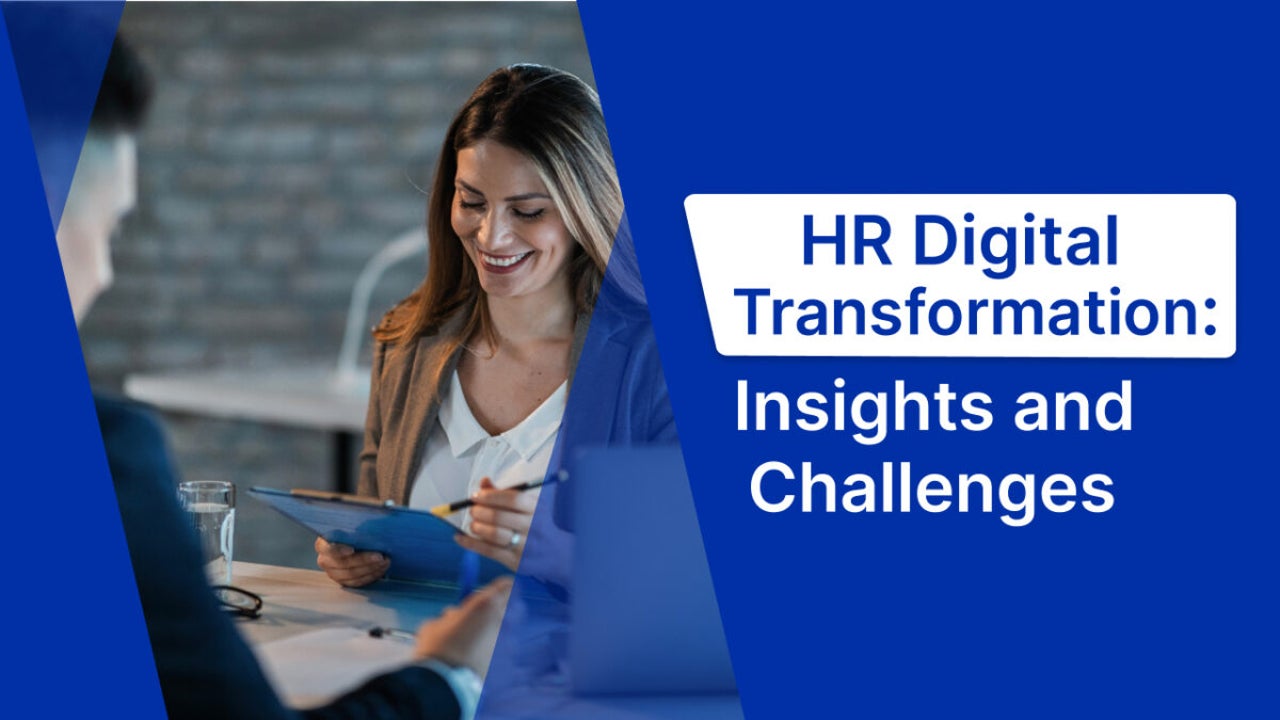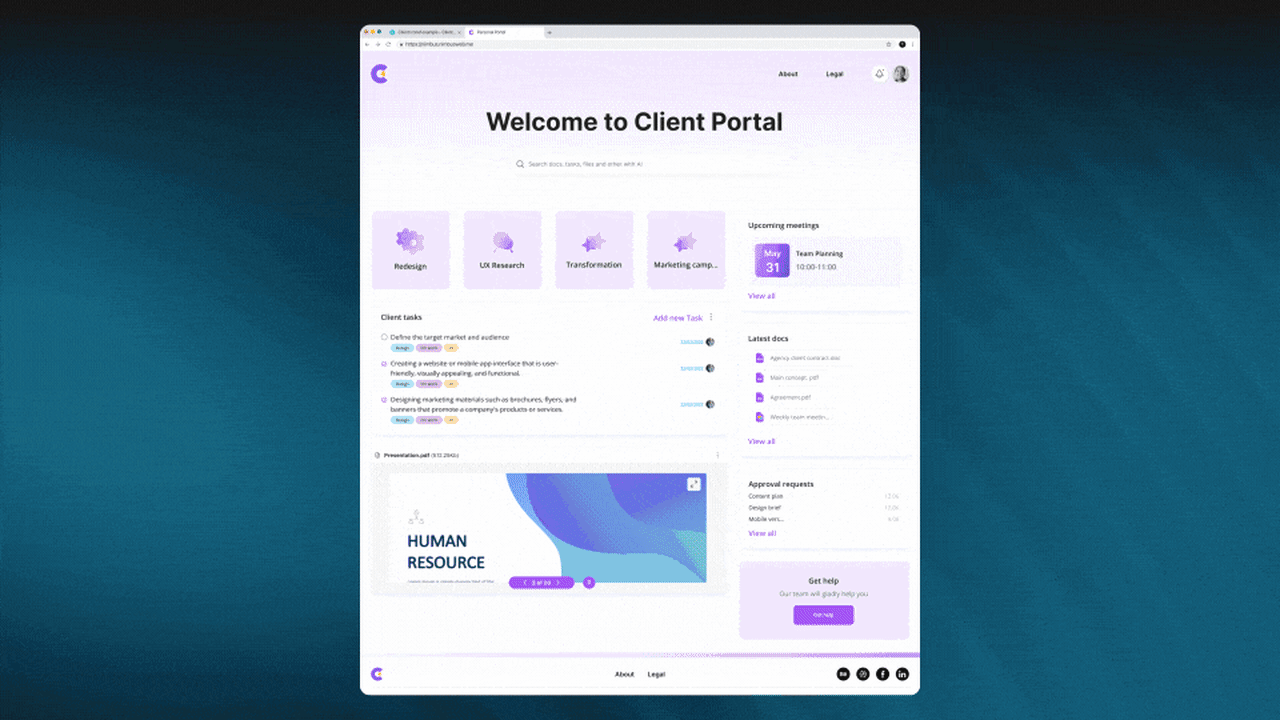Article
HR Digital Transformation: Insights and Challenges
Explore our 2024 guide to learn about HR digital transformation, including its benefits, challenges, and transformation stages

- January 31, 2024
- Updated: July 2, 2025 at 12:08 AM

Imagine a future where companies engage employees like never before, where data drives decisions and the workplace has transformed into an engaging, efficient and highly personalized place—this is HR digital transformation. Its effects can be felt across industries, from startups to multinational corporations. But what exactly does successful HR digital transformation entail and why has it generated such hype in business circles?
In this article, we’ll reveal what HR digital transformation is. We will analyze its profound impacts, uncover rewards and obstacles associated with digital HR transformation efforts and reveal the stages that lead to success. By the end of this article, you will hold keys for unlocking an entirely new era of HR practices that reimagines how businesses and employees connect and thrive!
Now, let’s get started.
What is HR digital transformation?
Human Resource Management is currently experiencing an immense transformation due to digitalization. New policies favor eliminating manual HR processes and time-consuming paperwork processes to automate them—increasing productivity, efficiency and operational resilience due to HR digital transformation across enterprises.
HR digital transformation represents an overall transition for any successful enterprise. Businesses can bolster operations by adopting digital tools, components, machine learning technology and systems into their operations systems to streamline them more efficiently.
Human resources (HR) digital transformation refers to moving HR functions from their current paper-based location into digital format to gain more autonomy and efficiency through cutting-edge technologies like automation, data analytics, chatbots and client and customer onboarding software, making it an ongoing process.
Why is HR digital transformation important?

HR changes must have clearly outlined goals to be effective and long-lasting. Any adjustments must be economically sensible for long-term viability and growth.
Transforming HR operations can increase productivity, decrease expenses and enhance employee experience. HR may become an active partner in driving success for any organization with automation and analytics technologies that facilitate faster decision-making processes and smooth operations.
HR digital transformation has become an indispensable element of today’s business world, empowering HR professionals to serve as strategic partners while improving employee experiences and contributing to overall business success.
Benefits of HR digital transformation
Increased employee happiness and engagement
As your business expands, more staff are needed to handle its increased workload. The HR office, in particular, may require extra staff members like individual HR employees. HR digital transformation offers several solutions for unifying resources and streamlining interactions, contributing to increased employee and customer satisfaction. Increasing connectivity keeps workers informed and interested while encouraging faster work processes.
Better Integration of People Management With Business Strategy
Workforce planning and human resources data can leverage HR technology to assist an organization with talent management and better aligning itself to its strategic goals. For instance, if expanding into new lines of business, data can show which employees possess the necessary expertise while others might require further training to expand successfully into said lines.
Improved deliberation based on reliable knowledge and data
COVID-19’s situation showcased how vital data-based decisions are, giving human resource representatives access to data-rich choices that could increase staff efficiency, effectiveness and productivity, ultimately enhancing the employee experience through technology’s computing power and analytical ability.
Eliminated paper-based HR procedures

Automation makes many administrative jobs more efficient by increasing compliance control and eliminating human mistakes, freeing HR professionals to focus on more strategic projects for their companies’ benefit and ultimately improving employee productivity.
Increased workforce visibility
Tracking employees dispersed across various locations can be challenging; technology makes this easier by connecting fragmented systems to gain full transparency over your workforce and extend it to managers for monitoring aspects like training needs and skills requirements.
Challenges of HR digital transformation
As part of our discussion about digitalization processes and issues organizations face during and after digitization efforts, we will look at several challenges companies might experience during or after digitization efforts.
Data Security and Privacy
Privacy and data security are of utmost importance in HR digital transformation. Organizations transitioning to digital HR platforms must protect sensitive employee information against increasingly prevalent cyber-attacks. This HR transformation process entails databases, cloud storage solutions, secure transmission channels and access control measures.
Employee Resistance
Employee resistance stems from our natural tendency as humans to resist change, particularly when new technology and work practices are involved. Employees may fear what lies beyond, feel anxious over job security concerns or require assistance adjusting to new tools and processes. Resistance can take many forms, from disengagement through passive opposition to active opposition. To overcome employee resistance, human resource professionals must implement effective change management strategies, communicating why change must happen while outlining the benefits of the HR operating model to employees as individuals and companies alike. Training employees on how to use digital tools can also reduce resistance levels.
Skill Gaps
As organizations start implementing digital technologies and advanced HR tools, companies often experience an uneven match between the skills required to use them and those held by HR professionals implementing them.
Organizations must provide learning and development training programs or upgrade HR staff members as a solution. offering courses like data analysis, digital HR platforms for HR automation technology or other technologies, including a digital learning platform, may help narrow this divide faster. Hiring digital HR specialists or working closely with outside consultants may also speed up the process.
Quality and Accessibility of Data
HR digital transformation relies heavily on data quality and access, including accuracy, availability and up-to-date HR tools like HRMS. Data quality helps HR processes become more effective while leading to more intelligent decision-making. Data cleansing, validation and standardization are critical steps toward maintaining high data quality; organizations should implement data governance frameworks to clearly articulate roles, responsibilities and standards within an organization.
Change Management
Change management is paramount in any HR digital transformation initiative as it addresses its human elements. Change management involves planning, implementing and communicating changes successfully so employees and stakeholders can adapt more quickly to digital transformation in HR. Without an effective change management strategy to support its success, its destiny could be in jeopardy.
How long does digital transformation take?
Timing of HR digital transformation varies between organizations depending on factors like size, existing IT infrastructure, scope of transformation, and commitment and acceptance for change.
Professionals estimate that once an overall concept of digital transformation in HR has been decided and agreed upon, its realization could take between 12-18 months to materialize. You can achieve a minimal viable transformation of your entire organization in 18 months. It’s best to implement HR digital transformation in phases. It allows organizations to test and adjust along the way. Some changes are relatively quick to implement, but a complete digital transformation can take several months or even years.
6 Stages of HR digital transformation when working with FuseBase (formerly Nimbus)
FuseBase (formerly Nimbus), a versatile collaboration platform explicitly designed for client-oriented businesses, plays an essential part in the HR digital transformation journey. FuseBase (formerly Nimbus) provides HR professionals with an intuitive platform that integrates communication, content management and essential tools into one streamlined package—providing HRs with the tools to successfully navigate digital transformation challenges. FuseBase (formerly Nimbus) collaboration platform excels at simplifying and improving every stage of HR digital transformation. Let’s delve into each stage of HR digital transformation and discuss how FuseBase (formerly Nimbus) can serve as an invaluable asset at each one.
Stage 1: Business as Usual
Business as usual is the first of the six stages where your HR digital transformation journey starts. This stage shows things are stuck in the past. Traditional HR operations remain prevalent, top business leaders are uninterested in change and the HR department is using outdated approaches. Everyone appears comfortable using old methods. Everybody’s focus seems more directed on maintaining the status quo and sticking with what’s familiar than shifting towards anything different and willing to raise digital literacy in the company.
FuseBase’s (formerly Nimbus) Knowledge Base feature can be especially valuable to organizations in Stage 1, where traditional HR methods remain prevalent due to leadership’s inability or unwillingness to change outdated solutions. By building accessible knowledge bases that incorporate digital technologies, companies preserve institutional knowledge while keeping vital insights alive even when leaders resist change. Documenting HR processes and practices into one centralized knowledge base prepares your entire organization for transformation while safeguarding essential HR knowledge.
Stage 2: Present and Active
Present and Active is the second of 6 stages of the HR digital transformation journey, where HR teams start getting curious about different methods of doing things. Big bosses are beginning to see the advantages of technology in HR, creative ideas surfacing and trials conducted on new technology or processes. In this stage, HR begins testing different ideas or processes while trying small experiments in an “I wonder what will happen” phase to optimize HR work processes and practices.

FuseBase’s (formerly Nimbus) Client Portals feature is an ideal fit to get the most out of this stage. HR employees can utilize this digital technology tool to easily create customized project portals branded to each employee.
With FuseBase (formerly Nimbus) you can:
- Centralize updates – Make updates more user-friendly by creating and organizing files into folders.
- Streamline approvals – Streamline approvals by receiving notifications directly on your dashboard when someone completes a task.
- Enhance communication – Transform employee communication by engaging via convenient chat channels.
This incredible feature provides users with an enhanced client experience while successfully implementing technology or process changes. FuseBase’s Client Portals provide HR departments a way of streamlining communication while creating the foundation for future transformation initiatives.
Stage 3: Formalized
Things have taken a significant turn in Stage 3: job applicants and employee data are now essential factors when making decisions. With everyone from big bosses guiding people on how best to use new systems to team members pitching in with their expertise to apply new tech across their companies—it marks an era where everyone works collaboratively to digitally transform the organization.
At Stage 3, FuseBase’s Data Collection feature is ideal when the HR team embraces data-driven decision-making and adopts new technology. This feature enables HR departments to easily embed forms, surveys and analytics into HR processes, streamlining data gathering from candidates and employees while discovering information discrepancies & formalizing data use for decision-making purposes. As executive members guide organizations into adapting new systems efficiently, Data Collection ensures each team member contributes their expertise for accurate HR data gathering & storage.
Stage 4: Strategic
Stage 4 is one of the stages of the digital HR transformation journey where things start moving rapidly. Those responsible for leading HR changes sit directly under their big boss, so convincing people of digital changes is no longer required. Now is when planning for future HR operations is key; you are building an expanded road and google map of technological solutions that spans years into the future.
FuseBase’s collaboration feature is essential in supporting digital HR transformation projects involving multidisciplinary teams and long-term planning by offering comments, chats, Video/Audio Recording capabilities and Real-time Collaboration features that facilitate successful results for organizational transformation efforts.
- Comments provide an ideal platform for team discussions around HR transformation strategies and long-term plans.
- Chats offer real-time communication channels for multidisciplinary teams, providing instant discussions, updates sharing and brainstorming sessions regarding HR transformation roadmaps.
- Video and Audio Recording help users to make sure they’ve captured important meetings, discussions and presentations related to HR transformation strategies to safeguard key dialogue for reference and future planning purposes.
- Real-time Collaboration tools enable teams to work simultaneously on documents, plans and strategies—this feature is particularly valuable when developing HR transformation roadmaps that integrate HR across every facet of business operations.
Stage 5: Converged
Stage 5 of HR strategy development focuses on making employee lives exceptional. By engaging creative HR teams and outside help to optimize how new hires are welcomed, learning strategies implemented, goals met and achievements reached, you are looking for ways to create an incredible employee experience—moments that bring people joy while improving job performance. Hence, employees remain with your company long-term. At this stage, HR leaders guide company strategy and operations while initiating exciting changes within HR operations/strategies with more rewarding employee benefits for all staff involved.
FuseBase (formerly Nimbus) allows you to invite external experts and agencies into your client portal, giving them access to documents and resources they’ll require for specific projects—opening doors to innovation!
This feature allows you to collaborate closely with external partners, enabling them to contribute their expertise directly into specific folders or generate novel ideas. It also simplifies collaboration and innovation, ultimately leading to improved employee engagement and efficiency within HR at this stage of its journey.
Stage 6: Innovative and adaptive
Stage 6, the last one of the stages of HR digital transformation, involves testing out new things and exploring what’s possible. Your digital transformation team resembles an inventive group, working closely with other departments and testing seemingly offbeat ideas, such as HR transformation. Though experimentation doesn’t always go smoothly, they continue with it anyway! At this stage, all those within an organization start seeing things differently; digital transformation becomes part of everyday work life for employees like an entirely new world reveals itself! Digital transformation becomes the new normal—something out of science fiction that makes all other work possible!
FuseBase’s integration feature is truly game-changing for this final stage; it acts as an arsenal of gadgets you can connect to FuseBase (formerly Nimbus) seamlessly.
So, suppose one of your colleagues develops a unique feature in another tool, finds an intriguing website reference or creates an incredible design flow in Figma. In that case, you can seamlessly incorporate those innovations into FuseBase (formerly Nimbus).
FuseBase (formerly Nimbus) serves as an open doorway to new ideas, offering you a portal into all the creative and innovative experiments being performed across your organization. By harnessing FuseBase (formerly Nimbus) for these experiments, you keep digital transformation rolling forward despite some unconventional concepts; digital transformation will become a normal part of the company’s life!
HR digital transformation examples
Digital Onboarding
Thousands of people have been employed after the pandemic and never set foot inside a company’s office, which makes it harder to get started in a new company. The increasing popularity of remote and hybrid work makes this a constant challenge.
In some cases, what used to be a few anxious days while new employees got to know their colleagues and their company culture has been replaced with a feeling of disconnection from their company and its culture.
Through its digital employee onboarding process, FuseBase (formerly Nimbus) serves as a bridge that introduces new employees to their company culture and processes, whether they are working remotely, following a hybrid schedule or are office-based. Employees access documents, instructional material and essential resources through an employee portal. Widgets housing process documents, task lists and clickable checklists make onboarding procedures accessible and smooth for newcomers. With integrations like Calendly, they can seamlessly schedule meetings with mentors or colleagues without feeling disconnected from their company culture and goals. FuseBase (formerly Nimbus) turns remote onboarding from a disjointed effort to an integrated experience for employees.
Performance management
It is evident that the board representative’s execution was an HR waste, as it required manual auditing and an assortment of assessment structures. The robotization of these paper-based, monotonous cycles will increase profitability and maintainability through better critique, objective setting and more preparation opportunities.
Determining and discussing goals with representatives is critical to the execution of executives. Representatives and directors can monitor the achievements of executives in an exhibit of their framework with robotization. After implementation, the information allows HR offices to identify bottlenecks. Using automation, notifications and updates are sent to both representatives and administrators to promote the culmination and completion of important achievements.
FuseBase (formerly Nimbus) stands as an invaluable ally for HR digital transformation efforts, automating time-intensive processes like manual collection of employee feedback and review of assessment forms through FuseBase (formerly Nimbus) to increase efficiency and promote employee retention. One notable feature is HR’s Task Management system, through which employees and HR can assign tasks to new hires and monitor their completion. With the help of this important digital technology, employees then mark tasks complete, allowing HR to evaluate performance objectively and adapt training or support accordingly. FuseBase (formerly Nimbus) streamlines the onboarding process and ensures employees are actively engaging and aligning themselves with organizational goals. Furthermore, tracking and notifications features help HRs pinpoint bottlenecks within processes so important milestones are reached efficiently and smoothly.
Employee Self-Service Portals
A McKinsey report found employees spent nearly a full day every week searching for company information, including basic human resources data. “How much time can I take off? Who do I call when I am sick? What is the best way to get my W-2 form from 2 years ago?”
FuseBase (formerly Nimbus) makes this process simpler by offering its powerful Knowledge Base feature, enabling HRs to quickly build an employee knowledge repository containing essential info that is readily accessible for easy reference.
This is one of the best digital HR solutions that help employees quickly locate answers to common employee inquiries in this centralized knowledge base, freeing them to seek solutions independently while alleviating HR professionals of some burden. Not only is FuseBase (formerly Nimbus) efficient, but it also fosters an atmosphere of self-service and knowledge empowerment within your organization.
Summing up: HR digital transformation best practices

Human Resources Digital Transformation can have powerful positive results on business. Successful HR digital transformation depends on many factors, including strategic alignment and leadership support, data-driven decision-making and implementation, change management, user-centric design, collaboration/sustainability and continuous improvement. HR digital transformation provides a way for organizations to create environments that are employee-friendly and adaptable at the same time. This article covers the best practices that will aid your company’s transformation processes if appropriately implemented. Good luck with your transformation journey!
Latest from Sabina Sher
- Understanding VoIP: Basics and Benefits of Using in 2024
- How to Get a Business Phone Number: Top 7 Apps for Customer Service and E-commerce Platforms in 2024
- Unlocking Privacy: How to Get a Second Phone Number for Enhanced Security and Communication
- Dialing Success: Top 7 VoIP Providers for Small Businesses
You may also like
 News
NewsThis year there won’t be an iPhone 18: what sources are saying and why there’s a catch
Read more
 News
NewsWe have waited 20 years for this Marvel hero to have a fair ending
Read more
 News
News2026 will not be the year when this highly anticipated saga returns
Read more
 News
NewsNetflix cancels the upcoming series by the Duffer brothers
Read more
 News
NewsTrump strikes back at George Clooney after the actor called him an idiot
Read more
 News
NewsYou can now watch the trailer for the most anticipated superhero series
Read more